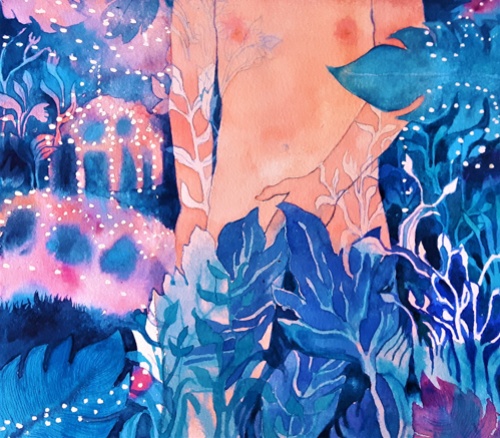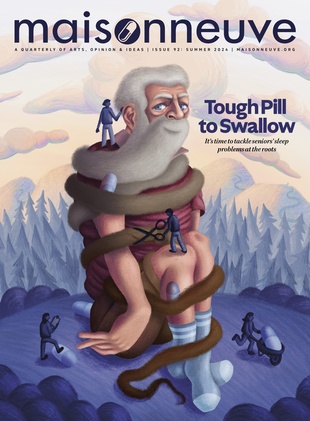 Illustration by Sara Khan.
Illustration by Sara Khan.
Gilding the Willy
When bodies are used as brushes, writes Mica Lemiski, it’s better to be the artist than the muse.
When Brent Ray Fraser squirts a tube of black paint onto his penis during a Ladies’ Night strip show, he’s only an arm’s length away from where I’m perched on a coveted perv-row stool. His groin looks like the unfortunate target of a squid-inking. The Wednesday night bacchanalia—disco balls, shiny poles, purple light that electrifies the dryer lint on my tights—is so overwhelming that I momentarily fail to notice the canvas being set up stage-left.
Once I see the canvas, I see the woman beside it. She’s in her forties or fifties, wide-hipped, wearing the kind of non-outfit better suited to buying emergency toilet paper than a night out at Brandi’s Exotic Show Lounge. An outsider among tiara-wearing bachelorettes, she blushes as Fraser directs her towards an onstage chair, where she sits and waits.
He begins to paint.
Rubbing his penis against the canvas, Fraser starts to draw the woman’s face as the audience screams so loudly I’m afraid my iPhone screen might crack. He holds his flaccid shaft like a paintbrush. He doesn’t mash it into the fabric or thrust wildly; he recreates his subject’s short curls and thick glasses as if putting the feathery touches on a cloudscape. For someone who goes by “Officer Hardonski” in his online workout videos, his brushstrokes have a surprising delicacy. Stranger still, the portrait is actually good—a fair likeness of the woman, and far beyond the level of quality you’d expect from an appendage as graceless as a dick.
As the bass pounds, I wonder about the sexual politics of a man rubbing his genitalia all over a representation of a woman’s face, but after two nine-dollar beers, I’m content to watch Fraser and his English-cuke-of-a-dong shimmy around the canvas. With my cohort of boisterous girlfriends, I couldn’t be having a better time. Gloria Steinem, forgive me.
It’s a misty October afternoon when I see Fraser next, one week after the strip show. He stands in the gravel driveway of his acreage in Langley, and although he’s wearing dark jeans and a grey V-neck, I instantly picture him naked. He shakes my hand with the friendly but self-conscious energy of a teenager interviewing for a dishwashing job.
I’ve since found that Fraser has some credibility as an artist: in 2009, he was commissioned by Louis Vuitton to paint shoes at their Canadian conventions (by hand). His performance videos have been showcased at galleries such as the Guggenheim, MoMA and Tate Modern, and he has a degree from Emily Carr.
After offering me some kale from his garden, Fraser leads me to his grain silo, a structure that has been converted to serve as part studio, part living space, part something harder to describe. Inside, it’s like a glittered-up hobbit hole. There are muffin tins for ceiling tiles, clusters of disco balls that hang from above like fruit, dozens of lava lamps, and a collection of penis statues—all neon, all erect—perched like strange birds around the room.
Next, we enter his studio proper, which is housed in a large barn adjacent to the silo. The building is full of huge canvasses, furniture and lumberjack tools, as well as an enormous bin that contains hundreds of Barbie dolls. “What’s with the dolls?” I ask. He intends to use them as a “live studio audience” during videos and streaming webcam shows, posing their limbs and using stop-motion techniques to make them laugh, boo and applaud.
Fraser then asks if he can video record our interview because he might need the footage for a “series of the self,” another indication that his true obsession might have more to do with hypervisibility than hypersexuality. Everything he does—at least as it pertains to his art—must be seen, whether by a live audience, a camera, his over twenty thousand Chaturbate followers (a streaming cam site where he penis-paints), the 2015 viewers of La France a un incroyable talent (France’s version of the Got Talent format), or an infantry of Barbies.
“I find it very hard to paint without an audience,” he says, in the barn. “I grew up painting by myself, but I can’t seem to do that anymore. I always have to have a camera recording me, and the camera will always act as an audience—whether or not there’s someone behind it.”
Fraser might be a perfect, if extreme, symbol of life in the digital age. With his enormous online presence (it’d take a full week to comprehensively tour his website, which shows hundreds of his paintings, photos and videos), he’s taking exposure to the next level. Even though most of us do not show our genitals to online communities or club-goers—at least not on purpose—Fraser’s need to be seen and heard and liked is near-universal. And his penis is just the tool he’s using to build that following. “As an artist you live a life to expose yourself,” he says. “And if my dick’s gonna get me there, then that’s what I’m going to do.”
The vulnerability that comes along with this choice is what sets Fraser apart from his obvious forerunner, Yves Klein. Klein was a mid-twentieth-century French painter perhaps best known for his “Anthropometry” series, which he created by smearing women’s naked bodies with blue paint and having them roll across huge canvasses under his strict direction: “a little to the right; over to the left now.” He called these women “living brushes” and said their nakedness was paramount because “only the essential, pure affective climate of the flesh is valid.” But, crucially, Klein never saw himself as a living brush. He preferred to don white gloves and a tuxedo while telling women to do things like press their left breasts more firmly onto a tarp. He was, in many ways, a product of his time—women as objects, men as auteurs—as Fraser is a product of ours, when everyone is on display, their own work of art.
In making art with his lacquered dong and letting us view the process, Fraser isn’t completely unique (see: Australia’s “Pricasso,” or Iceland’s “PErró”) but he’s personally branded himself in an attention-getting way, which is what we’re told to do if we want success in any field—art, music, real estate, selling grilled cheese from a food truck. In 2017, collapsing the distance between product and self is a marketing strategy, whereas in Klein’s era, one’s own omnipresence wasn’t prioritized, either for business reasons or psychological comfort.
Back in the barn, what Fraser says next catches my attention: “It’s just a beautiful thing for someone to paint and imprint their body.” He’s not referring to penis-painting other people’s likenesses, but to making imprints of himself. He calls these scrotal stamps “self-portraits” and claims that, like fingerprints, they are wholly unique. In his mind, what makes a genital imprint transcend the beauty of a fingerprint is the life force behind it. “Whether it’s the female part or the male part,” Fraser says, “these are things that create life.”
As someone who writes about my own experiences, trying to make tangible, meaningful representations of the self, I understand the appeal of imprinting a body in paint—seeing my own life force in a colour and on a canvas of my choosing.
A week after the interview in Fraser’s barn, I’m alone in my apartment. The blinds are shut and I’ve shoved the furniture to the edges of the room. A week’s worth of flyers paper the hardwood.
I’ve placed a nine- by twelve-inch canvas on a stool, and beside it, a box of acrylics, a yogurt-lid mixing palette and a handful of brushes. The music I’ve chosen is by Sarah Slean, an album appropriately titled The Baroness Redecorates, and as I take off my clothes and consider my angle of impact, I wonder what I’ll do with the finished product. Labia are generally not very dexterous, so I’m not expecting a masterpiece. I’ll probably shove my unsightly art into the closet.
After brushing myself with a mix of Lake Blue, True Indigo, Fire Red and Plain White, I begin to squat, smoosh and stamp. I’m like a child who’s been left alone in a white-walled room full of Sharpies—the painting takes five or ten minutes, and it’s pure glee.
Maybe this is how Carolee Schneemann felt in 1963, when she created her infamous “Eye Body” photograph series, which depicts the artist sprawled across a canvas and covered in paint, chalk, grease, feathers, fur, a few plastic snakes. The series was immediately dismissed by critics who flagged it as narcissistic self-indulgence, but it opened up a space for other women artists (Hannah Wilke, Elke Krystufek) to show female nudity in a way that didn’t cater to male fantasy. One of Schneemann’s goals in creating “Eye Body” was to reclaim authority over the female body and its depiction, because even though naked women had long been placed on pedestals in the art world, they’d rarely been seated on their own terms.
During our interview, I asked Fraser if he thought it problematic to paint women’s faces with his junk. Blushing, he gave a standard answer about provocation being the job of an artist. Art should disturb the comfortable and all that. He assured me his subject—a self-identified “super fan”—fully consented to having her likeness dick-drawn that night. But I don’t think I want a man’s penis in charge of my representation. Being a muse means letting another person decide which version of you is worth admiring, and—while the artist-muse relationship can be beautiful, even sacred—self-sacrifice is inevitable when creative choices are made about you and not by you. I’d rather take the Schneemann approach: build my own pedestal, and choose for myself how to pose (or squat) on top.
When I’ve finished leap-frogging, I clutch the canvas at arm’s length and examine my work. It’s highly abstract, but I see myself: the tiny creases of skin, my body’s map. I sprinkle the wet prints with a pinch of gold glitter because something about this feels magical. I look at the blobs of colour, and they remind me of fairy wings.
Setting the painting down, I walk into my bathroom and stare at myself, naked and painted. I take a mirror selfie, and I like the photo. And not “like” as in I click a button; “like” as in I feel good about my body, all the things it can do. I return to the living room, pick up the painting and know instantly that this is not the funny secret I thought it’d be. It’s going straight on the bedroom wall.





